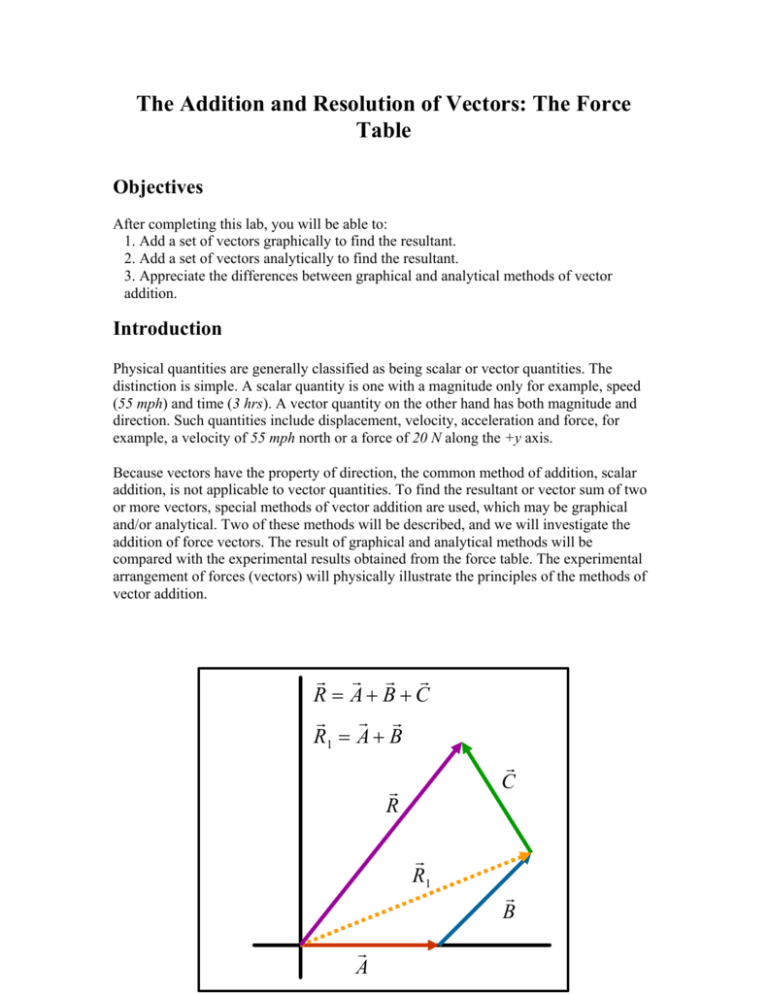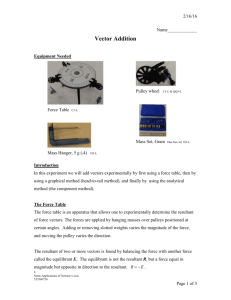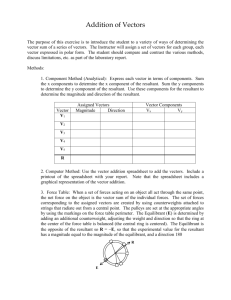The Addition and Resolution of Vectors: The Force Table
advertisement

The Addition and Resolution of Vectors: The Force Table Objectives After completing this lab, you will be able to: 1. Add a set of vectors graphically to find the resultant. 2. Add a set of vectors analytically to find the resultant. 3. Appreciate the differences between graphical and analytical methods of vector addition. Introduction Physical quantities are generally classified as being scalar or vector quantities. The distinction is simple. A scalar quantity is one with a magnitude only for example, speed (55 mph) and time (3 hrs). A vector quantity on the other hand has both magnitude and direction. Such quantities include displacement, velocity, acceleration and force, for example, a velocity of 55 mph north or a force of 20 N along the +y axis. Because vectors have the property of direction, the common method of addition, scalar addition, is not applicable to vector quantities. To find the resultant or vector sum of two or more vectors, special methods of vector addition are used, which may be graphical and/or analytical. Two of these methods will be described, and we will investigate the addition of force vectors. The result of graphical and analytical methods will be compared with the experimental results obtained from the force table. The experimental arrangement of forces (vectors) will physically illustrate the principles of the methods of vector addition. G G G G R = A+ B +C G G G R1 = A + B G C G R G R1 G A G B Triangle (Head to Tail) Method Vectors are represented graphically by arrows. The length of a vector arrow (drawn to scale on graph paper) is proportional to the magnitude of the vector, and the arrow points in the direction of the vector. The length scale is arbitrary and usually selected for convenience and so that the vector graph fits nicely on the graph paper. A typical scale for a force vector might be 1 cm = 10 N. That is each centimeter of vector length represents ten newtons. The scale factor in this case in terms of force per unit length is 10 N/cm. G G To add two vectors a triangle of which A and B are adjacent sides is formed. Vector arrows may be moved as long as they remain pointed in the same direction. The arrow G that is the hypotenuse of the triangle is R1 (see figure above) the resultant or vector sum G G G G G of A + B or, by vector addition, R1 = A + B . The magnitude of R1 is proportional to the length of the diagonal arrow, and the direction of the resulting vector is that of the G G resulting vector is that of the diagonal arrow R1 . The direction of R1 may be specified as being at an angle relative to the x-axis. Polygon Method If more then two vectors are added, the head-to-tail method forms a polygon (see figure G G G G above). For three vectors, the resultant R = A + B + C is the vector arrow from the tail of G G the vector A to the head of the vector C . The length (magnitude) and the angle of G orientation of R can be measured from vector diagram using a ruler and a protractor. G Note that this equivalent to applying the head-to-tail method (two vectors) twice ( A and G G G G G B are added to give R1 , then C is added to R1 to give R ). Component Method y G B G A Ry = Ay + By G R x Rx = Ax + Bx G We may resolve any vector into x and y components. That is, a vector R is the resultant G G G of Rx and R y , and R = Rx + R y where Rx = R cos θ and R y = R sin θ . The magnitude G and the direction of R is given by R = Rx2 + R y2 ⎡ Ry ⎤ ⎥ ⎣ Rx ⎦ θ = tan −1 ⎢ The vector sum of any number of vectors can be obtained by adding the x and y components of the vectors. The magnitude of the resultant is given by R = Rx2 + R y2 , ⎛R ⎞ where Rx = Ax + Bx + C x + ... and R y = Ay + B y + C y + ... and θ = tan −1 ⎜ y ⎟ . R x⎠ ⎝ The force table is an apparatus that allows the experimental determination of the resultant of force vectors. The rim of the circular table is calibrated in degrees. Weight forces are applied to a central ring by means of strings running over pulleys and attached to weight hangers. The magnitude (which is the mass times the acceleration due to gravity) of a force (vector) is varied by adding or removing slotted weights, and direction is varied by moving the pulley. G F1 G E Equilibrant G R Resultant G F2 The resultant of two or more forces (vectors) is found by balancing the forces with another force (weights on a hanger) so that the ring is centered on the center pin. The G G balancing force is not the resulting R , but rather the equilibrant E , or the force that balances the other forces and holds the ring in the equilibrium. The equilibrant is the vector force of equal magnitude, but in the opposite direction, to G G the resultant (i.e. , R = − E ) like the above diagram. Apparatus: 1. Vector Force table 3. Graph paper 5. Protractor 2. Masses on hangers 4. Ruler 6. String Procedure 1. Mount a pulley on the 20° mark on the force table and suspend a mass of 100 g over it. Mount a second pulley on the 120° mark and suspend a mass of 200 g over it. Draw a vector diagram to scale, using a scale of 0.2 N/cm, and determine graphically and analytical the direction and magnitude of the resultant by using the triangle method and the component method (see above). Note that your weights are labeled according to their masses in grams but that you are dealing with forces measured in newtons. 2. Check the result of Procedure 1 by setting up the equilibrant on the force table. This will be a force equal in magnitude to the resultant, but pulling in the opposite direction. Set up a third pulley 180° from the calculated direction of the resultant and suspend masses over it giving a weight equal to the magnitude of the resultant. Cautiously remove the center pin to see if the ring remains in equilibrium. Before removing the pin, make sure that all strings are pointing exactly at its center; otherwise the angles will not be correct. 3. Mount the first two pulleys as in Procedure 1, with the same weights as before. Mount a third pulley on the 220° mark and suspend a mass of 150 g over it. Draw vector diagram to scale and determine graphically the direction and magnitude of the resultant. This may be done by adding the third vector to the sum of the first two, which was obtained in Procedure 1. Also add up the three vectors using the component method. Now set up the equilibrant on the force table and test it as in Procedure 2. 4. Clamp a pulley on the 30° mark on the force table and suspend a mass of 150 g over it. By means of a vector diagram drawn to scale, find the magnitude of the components along the 0° and the 90° directions. Set up these forces on the force table as they have been determined. These two forces are equivalent to the original force. Now replace the initial force by an equal force pulling in a direction 180° away from the original direction. Test the system for equilibrium. Data: Resultant R (magnitude and direction) Forces Graphical Analytical F1=100g θ1=20º Vector Addition 1 F2=200g θ2=120º F1=100g θ1=20º Vector F =200g θ2=120º Addition 2 2 F3 =150g θ3=220º Vector F=150g θ=30º Addition 3 Fx Fx Fy Fy Questions 1. State how this experiment has demonstrated the vector addition of forces. 2. In procedure 3, could all four pulleys be placed in the same quadrant or in two adjacent quadrants and still be in equilibrium? Explain. 3. The forces used in this experiment are weights of known masses, that is, the forces exerted on these masses by gravity. Bearing this in mind, explain the function of the pulleys. 4. State the condition for the equilibrium of a particle.






